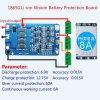I am pretty well versed in the aspect of Batteries with NiMh and am well aware of the shortcomings of both NiCad and Lead Acid types.
But now I find myself wishing to do some smaller projects using Battery Power and may for these be tempted to go along the Lipo / Lion or other routes as may be advised in this thread.
But a few down sides as I understand them, Rik has posted a few notes in his blog about the use of Lion as follows ‘NOTE: It is unlikely you will find protected li-ion batteries with tabs as they should not be connected together in packs.’ so I wonder just how safely can one get up to or a little over 12v using these with say 4 in Seriies? And how can one charge them safely? I have also heard worrying horror stories about Lipo’s spontaneously combusting. Though I happiliy use a Mobile Phone and iPads with a type of Battery that may be one of these types.
I suspect that some Manufacturers may be able to assist with the correct supply of Batteries and Chargers for my requirements, but I feel that I need a warm comfy feel about a direction Lipo or Lion.
Also bear in my that I am looking for a smaller type of Battery as I will be wanting to incorporate DCC Sound in these projects using the Fosworks DCC Battery set up.
Any help / advice will be appreciated.
But now I find myself wishing to do some smaller projects using Battery Power and may for these be tempted to go along the Lipo / Lion or other routes as may be advised in this thread.
But a few down sides as I understand them, Rik has posted a few notes in his blog about the use of Lion as follows ‘NOTE: It is unlikely you will find protected li-ion batteries with tabs as they should not be connected together in packs.’ so I wonder just how safely can one get up to or a little over 12v using these with say 4 in Seriies? And how can one charge them safely? I have also heard worrying horror stories about Lipo’s spontaneously combusting. Though I happiliy use a Mobile Phone and iPads with a type of Battery that may be one of these types.
I suspect that some Manufacturers may be able to assist with the correct supply of Batteries and Chargers for my requirements, but I feel that I need a warm comfy feel about a direction Lipo or Lion.
Also bear in my that I am looking for a smaller type of Battery as I will be wanting to incorporate DCC Sound in these projects using the Fosworks DCC Battery set up.
Any help / advice will be appreciated.








